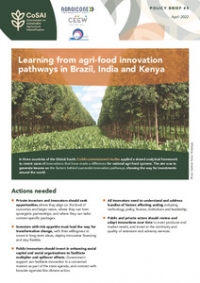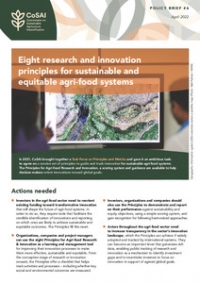High quality evidence is important if we are to scale sustainable agriculture practices effectively. The difficulty lies in understanding how investments in research lead -- via the complex landscape of policy, incentives and tariffs -- to positive change on the ground. The CGIAR Research Program on Water, Land and Ecosystems (WLE) commissioned an external evaluation to understand how an array of interlinked research on soil and water management has helped to advance sustainable rural livelihoods in Ethiopia.
The findings show that WLE has stimulated a common way of working in Ethiopia that makes opportunities, and responding to them, more likely. By facilitating this approach -- termed impact tracking -- WLE has helped its partners bring about real change in three specific areas: demonstrating landscape approaches to agricultural management in ways that encourage farmers, the government, donors and NGOs to embrace these strategies; innovating with geospatial data to underpin agricultural decision-making; and promoting and removing barriers to conservation technologies to stimulate economic development.
WLE's impact tracking works in several ways. It encourages senior Ethiopian-based researchers to use their professional networks to advance projects, using a set of behaviors akin to 'product championing' in industry. It enables partners to undertake demand-driven work in line with national priorities, with the involvement of government partners. And it facilitates responses to a dynamic and changing funding environment, supporting work to continue even when faced with funding cuts. Finally, it encourages the long-term continuity of concepts, such as taking a common landscape approach.
"The evaluation team recommended our impact-tracking methodology be systematized and promoted, with the hope that other programs might be able to follow WLE's example and trigger major change with relatively little funding, explains WLE Program Director Izabella Koziell. "They found the scope and potential magnitude of ten 'outcome trajectories' to be impressive for an annual investment of less than USD 6 million. Some of these pathways had contributed to thousands of households adopting new and improved soil conservation technologies and water management practices, and there was potential for greater change still."
Integrated natural resource management and landscape initiatives in Ethiopia are generally long-term and complex, involving transdisciplinary teams working to achieve both food production and environmental goals within a specific geographical area. The two WLE Flagship Programs that have contributed the most to work in Ethiopia are Restoring Degraded Landscapes and Land and Water Solutions for Sustainable Intensification. These are collaborative initiatives, involving the International Centre for Tropical Agriculture (CIAT); World Agroforestry Centre (ICRAF); International Crops Research Institute for the Semi-Arid Tropics (ICRISAT); and International Water Management Institute (IWMI).
Identifying clear impacts from such initiatives can be challenging. However, it is possible to define outcome trajectories; essentially patterns of interactions and causal links between actors that unfold over time. The evaluation team found that WLE had directly contributed to ten such outcome trajectories, which naturally coalesced under the three areas of change outlined above. WLE had primarily provided funding or acted as a catalyst to bring interested parties together through joint research, for example by providing connections to international universities.
Making a difference on the ground
Work in Ethiopia's Amhara region exemplifies how WLE has helped promote change from demonstrating landscape approaches to agriculture. Here, in the Yewol mountains, an ICRISAT/WLE initiative to rehabilitate a micro-watershed involved terracing, upgrading springs and planting fruit trees. Following the project, local farmers reported a switch in mindset from working individually to laboring collectively to benefit the community; growing more crops in the dry season; planting a wider variety of crops; and introducing an improved breed of sheep that commanded a higher price at market. The evaluation found WLE could have even greater impact by bringing this work together with that of CIAT's to develop a common WLE approach.
Soil-plant spectral technology developed by ICRAF/WLE illustrates how geospatial data has helped to underpin decision-making in Ethiopia. This technology, which is used to map and monitor soil properties, formed the basis of a state-of-the-art soil information system established in Ethiopia. The information held in the system helped to inform recommendations for applying fertilizer. Improved crop responses were observed at large-scale demonstration trials conducted in farmers' and farmer training centers' fields.
The evaluation showed how this work was supported through research by CIAT and ICRISAT on improving data-sharing policy and tailoring fertilizer recommendations to position in the landscape, respectively. The overall goal is to provide farmers with bespoke soil fertility recommendations that could save Ethiopia billions of dollars through more efficient use of fertilizer.
An IWMI-WLE initiative to promote solar technology, meanwhile, demonstrates the use of conservation technologies to stimulate economic development. A study showed that pumps could bring an extra two million hectares of land under irrigated production if the technology cost less. Together with a trial of solar pumps, this work encouraged the government to approve tax exemption for all agricultural technology.
"The evaluation team suggested that, if continued in the longer term, these research areas could contribute to WLE's goal of enhancing the livelihoods of one million households in Ethiopia," says Koziell.
Download the full evaluation report here.





















